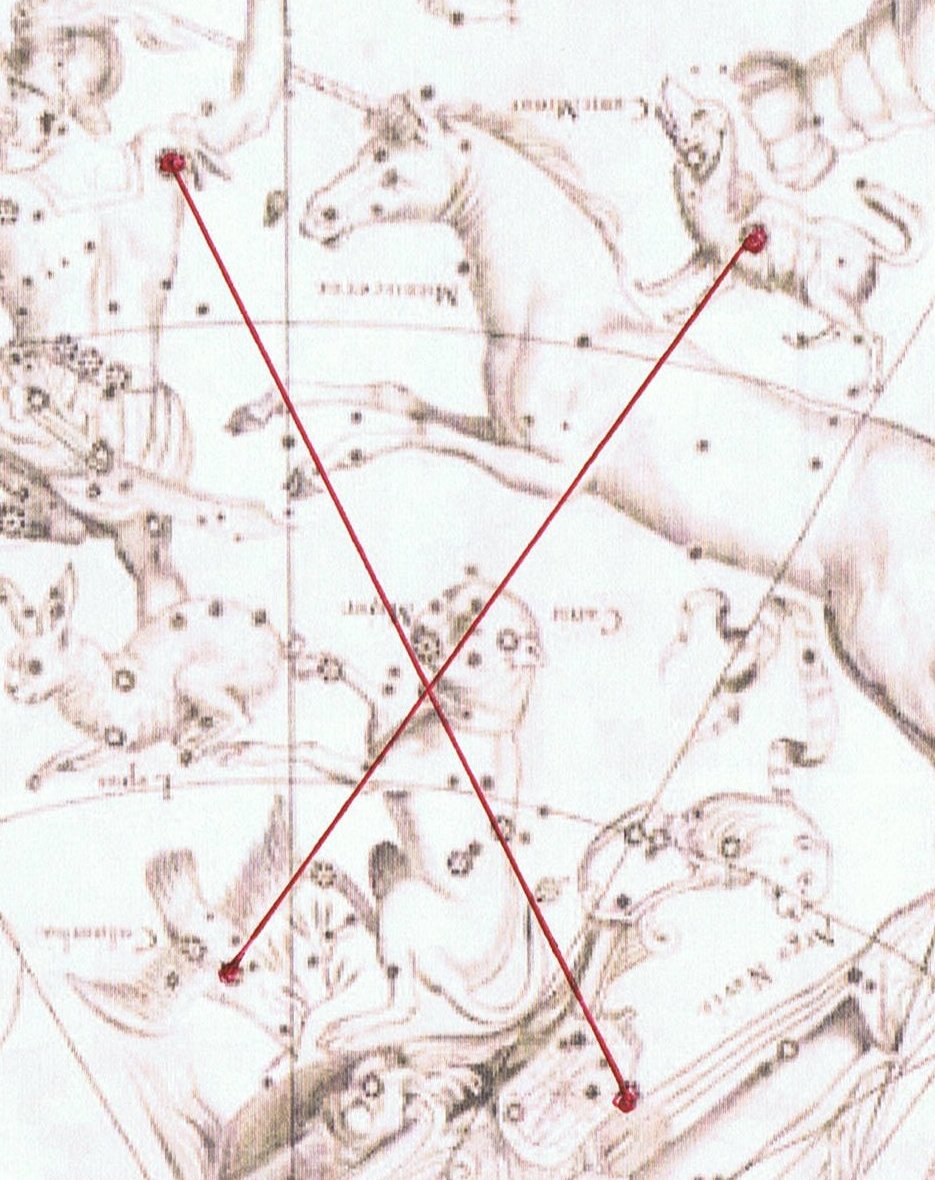|
5. In order to show where the Egyptian X is located I have copied a section of Hevelius' overview of the southern sky and drawn red lines between Betelgeuze and Naos respectively from Procyon to Phaet:
The great size of this X is on par with that of Argo Navis, and a great size is a Sign of importance. I have a type of glyph (hura) in my dictionary which possibly depicts the same constellation as the Egyptian X. However there is no evident hura sign in the G text. A few examples from other texts:
My name for this type of glyph, it should be observed, is not based on any firm usage by Metoro and hura is therefore for the moment just a label without any indication of what is illustrated. There is no central 'star stone' in any of these four examples nor in any of the other hura glyphs I have collected from the rongorongo texts. I guess Sirius is not a reliable point to have in the center - it moves too much. It should therefore be only a coincidence that the nose of Canis Major is close to the cross between the lines. On the other hand, it does not matter if the 4 corners in the Egyptian X are moving, the outline will remain basically the same. In e.g. Pa5-72 much suggests a position at the end of some kind of year:
57 * 2 = 114 = 6 * 19 (and 5 * 72 = 360). Although I will not take time to here write it down I am convinced the overwhelming majority of all the other signs in these glyphs point at the end of a year. Support for my statement is given also by the parallels in the A and H texts (while the shorter Q has no glyphs here). At the end of the ruling cycle is the 'center of gravity', 'the house of Horus' (Hat-Hor), and from there a new ruler will emerge, triumphant: ... The king, wearing now a short, stiff archaic mantle, walks in a grave and stately manner to the sanctuary of the wolf-god Upwaut, the 'Opener of the Way', where he anoints the sacred standard and, preceded by this, marches to the palace chapel, into which he disappears. A period of time elapses during which the pharaoh is no longer manifest. When he reappears he is clothed as in the Narmer palette, wearing the kilt with Hathor belt and bull's tail attatched. In his right hand he holds the flail scepter and in his left, instead of the usual crook of the Good Shepherd, an object resembling a small scroll, called the Will, the House Document, or Secret of the Two Partners, which he exhibits in triumph, proclaiming to all in attendance that it was given him by his dead father Osiris, in the presence of the earth-god Geb. 'I have run', he cries, 'holding the Secret of the Two Partners, the Will that my father has given me before Geb. I have passed through the land and touched the four sides of it. I traverse it as I desire ... If he did touch the 4 sides of the land, then the 4 corners in Egyptian X possibly indicate the corners of his land, or to be more precise - the land of Egypt could be a map of that region in the sky. This was before the great pyramids of Giza were built. Precession could have forced a change in the old map of Egypt, with Betelgeuze now at the end rather than at the beginning. The P text is not 'orthodox' and we cannot rely on it. In the parallel H text only the bottom half of X has been drawn:
62 * 8 = 496 = 16 * 31 (and 6 * 28 = 168). One might at first think time has obliterated the upper half of hura, but a thorough study reveals this is not the case - the creator of the H text had probably no intention to draw the upper half. We should therefore consider the possibility that the absence of the upper half is a Sign. Phaet has a lower right ascension than Naos and it should be at left in Ha6-28. |
||||||||||||||||||||||||||||||||||||||||





